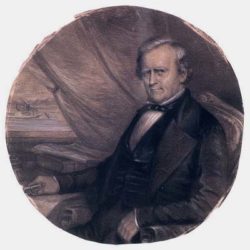Shreve Town Company
The Shreve Town Company was a for-profit business venture that led to the establishment of what is today known as Shreveport, the largest city in northwest Louisiana.

Wikimedia Commons
Henry Miller Shreve, illustrated late in life by George d'Almaine.
The common belief among Shreveporters is that their city was founded by Captain Henry Miller Shreve, the engineer hired by the US government in the 1830s to clear the Red River of the centuries-old logjam known as the Great Raft. In truth, the city of Shreveport was founded as a for-profit business venture by a group of seven partners, including Capt. Shreve, who himself was never a resident of the city. This partnership, called the Shreve Town Company, was influential not only in establishing the city that would become the largest in northwest Louisiana but also in ensuring its success.
Origins and Organization
The Shreve Town Company was established during a meeting held on May 24, 1836, at the residence of one of its members, Bushrod Jenkins. Those also in attendance included Capt. Shreve, James Belton Pickett, Thomas Taylor Williamson, and Angus McNeill.
Several months earlier, McNeill had been offered a 640-acre tract of land owned by Larkin Edwards, who had been granted the parcel under the terms of the Caddo Indian Treaty of 1835. Under the terms of the treaty, Edwards could choose any 640 acres he wished from within the lands ceded by the Caddo to the United States. The site he chose would ultimately be the location of what is now downtown Shreveport.
Edwards offered his reserve to McNeill for $5,000, and McNeill accepted. On February 2, 1836, the day after the treaty with the Caddo was ratified, the sale was finalized. Fifteen weeks later, McNeill was approached by Pickett, who suggested that he and others would like to use McNeill’s newly acquired land to establish a planned city, agreeing to pay him for their shares in the proposed company. The project, they argued, could be very profitable for McNeill.
Surveying a Location
McNeill proved amenable to the proposition set before him and suggested that the new town be established either on the bluffs close to the Texas Trail, where James Huntington Cane and William Smith Bennett operated a store, or on the bluffs above Wright Island where Jim Coates operated a store and a small settlement known as Coates Bluff had been established.
On May 27, the newly established Shreve Town Company held a meeting at Cane and Bennett’s store. Cane and Bennett now joined the company, as did an attorney from Natchez, Mississippi, Thomas Sturges Sprague, a close friend of McNeill’s. The six non-landholding partners paid McNeill a total of $4,166.66 for their shares. McNeill was elected president of the company, and Jenkins was elected treasurer. The venture was named in recognition of Capt. Shreve, whose previous clearing of the Red River logjam made the settlement of northwestern Louisiana possible.
Capt. Shreve set off for Louisville where he hired the city’s official surveyor, E. D. Hobbs, to draw up a map for the planned town. Copies were then made by lithographer C. R. Milne to be used in selling lots in the new community, Shreve Town, which would be situated on the upper bluffs where Cane and Bennett’s store was located.
The town site, as surveyed, was eight streets wide, running from Cross Bayou on the north to Silver Lake on the south. It was also eight streets deep, running back from the Red River on the east to the bottomland on the west. It thus occupied a ridge of high ground that would not be prone to flooding but nevertheless allowed easy access to the river; it was additionally bisected by the Texas Trail, an important overland route to the west.
From Shreve Town to Shreveport
On February 4, 1837, McNeill transferred the title of his purchase of Edwards’s reserve to the Shreve Town Company. He later argued that the other members of the company had tricked him into transferring this land to the corporation by promising to share in several similar parcels of land once granted; the others maintained that no such promises were ever made. Ultimately the whole affair led to bad blood between members of the company. Nevertheless, the business venture was successful, and Shreve Town made its members and their heirs a substantial profit. McNeill kept the matter open, however, and it continued to pass in and out of court until as late as 1881. With McNeill’s death in 1882, the affair ceased litigation.
In 1838 Shreve Town became Shreveport, and the next year the new town became the seat of the newly created Caddo Parish. However, not all the members of the Shreve Town Company lived to see its success within their lifetimes. Bennett died in 1837 before the town site was fully cleared; Sprague died the following year. Pickett died in 1842 while on a business trip to Kentucky, and Cane died suddenly in 1844. Two years later, Jenkins was murdered, his body found along the road between Anderson Island and Shreveport, stabbed with a Bowie knife. Shreve himself died in St. Louis in 1851 at the age of sixty-six. Only Williamson and McNeill lived to enjoy their old age. Williamson remained in Shreveport but moved to Texas in 1871 to be near his daughter; he died two years later. McNeill also went to Texas, residing at Eagle Lake until his death.
Mary Bennett Cane, the wife first of Bennett, then of Cane, and the widow of both, proved the greatest beneficiary of the Shreve Town Company’s profits. She inherited the shares of her two late husbands and also bought substantial tracts of land in Caddo and Bossier Parishes, as did her friend, Pickett’s widow, Pauline deGraffenried Pickett. Pauline died in 1899; Mary, in 1902. Both were wealthy women and prominent Shreveport landholders. With their deaths the last direct living links to the Shreve Town Company were severed.
